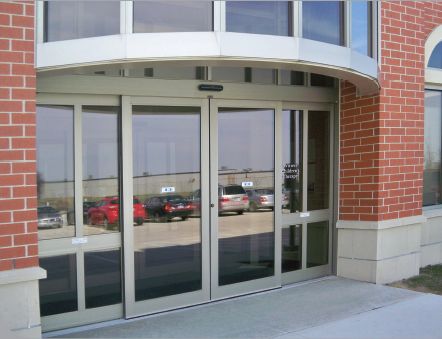 ×
×

Many of Dash Door’s clients are well versed in the various automatic door types and their general uses. We often find it helpful; however, to point customers who are “newbies” to automatic doors to the information below as provided by Christopher Johnson of the American Association of Automatic Door Manufacturers (AAADM). It is a good primer on automatic door “basics”.
Before specifying automatic doors for a hotel, restaurant or other hospitality-related application, you should have an understanding of the various types of automatic doors available and laws and standards that apply to you and your door. When automatic doors are properly selected, installed and maintained, they provide welcoming, convenient, secure access that tells your customers you care about them. The first impression is a lasting one, and automatic doors help you leave a positive impression.
The primary standard addressing automatic pedestrian doors is the American National Standard for Power Operated Pedestrian Doors, ANSI/BHMA A156.10. The latest version is dated 2005. The ANSI A156.10 standard provides details and specifications for installation that have been designed to provide a safe, properly functioning automatic door system. For example, the standard contains information regarding minimum or maximum dimensions, recommended forces, and layouts for various components of power-operated door systems. Members of the American Association of Automatic Door Manufacturers (AAADM), a trade association of power-operated automatic door manufacturers, comply with this standard. AAADM administers a program to certify automatic door inspectors. Further information can be obtained on the AAADM website, www.aaadm.com.
Whereas ANSI/BHMA A156.10 applies to full power automatic door systems, a related standard, ANSI/BHMA A156.19, American National Standard for Power Assist and Low Energy Power Operated Doors, provides similar information for low energy operator systems.
In addition to the ANSI A156.10 and A156.19 standards, an understanding and awareness of the following standards and codes is important for automatic doors and all access systems:
There are three major types of automatic doors: swinging, sliding and folding.
Automatic sliding doors provide effective two-way traffic. Sliding doors are equipped with a feature that allows the sliding door to swing when pushed out in emergencies. This feature, known as “breakout” or “breakaway”, qualifies them to be used in locations that require emergency egress capability. Sliding doors are offered in various configurations, including traditional biparting, single slide and telescoping models. These doors require an adequate amount of slide room in which the door can move. Sliding doors should always include appropriate sensors or control mats and safety signage.
Typically, when a swinging door is automated, two doors are used. One door swings inward and the other door swings outward. This enables two-way traffic. Two-way traffic through a single automatic swinging door is not normally recommended. The exception is a low-energy swing operator that has different characteristics than a fully automatic door. It is crucial that these types of doors are well marked to indicate the direction of travel.
Safety zones for swinging doors are covered in Section 8.1.2 of ANSI A156.10. Different requirements are in place for different systems. Requirements depend on what combination of sensors and control mats is used. There are two types of sensors for automatic swinging doors, overhead mount and door mount. Each has different characteristics and enables different pattern sizes and performance. Swinging doors should always include guide rails, sensors or control mats and safety signage.
A folding door requires minimal space to install, yet provides plenty of clear door space. This makes this type of door a preferred choice when space is at a premium. These doors should have an emergency swing feature if the door is being used as an egress location.
Automatic folding doors have two or more separate panels. The first panel swings and the second panel slides in a guide, enabling it to slide as both panels swing into a “V” shape, which is the fold. Automatic folding doors may include either a single folding door that swings in or out or a pair of doors that simultaneously fold in or out. Similar to swinging doors, folding doors should always include guide rails, sensors or control mats, and safety signage.
No matter the type of door, the automatic door system should be designed in such a way that traffic approaches the door in full view and users walk directly toward the door. Pedestrians must have excellent visibility of the door and its markings and must be able to clearly observe the direction of door travel. Avoid positioning vending machines, waste containers, pay telephones or anything else that has potential to distract users within four feet of the moving door.
The nature of the application is the most important factor in determining the type of automatic door that will be installed. Not all types of automatic doors are suitable for every application. You must take into account the desired traffic flow, typical types of users, available space, and aesthetic requirements or preferences.
With over 50 billion safe automatic door openings and closings every year in the United States alone, automatic doors boast an exceptional performance record. Automatic doors are manufactured with sophisticated technologies that are selected by manufacturers to provide efficient performance from each component of the door system. In addition, automatic doors and their sensing systems come with many built-in features that allow for added customization for specific applications.
Performance is enhanced when AAADM recommendations for proper installation and annual inspections, both performed by an AAADM-certified inspector, are followed.